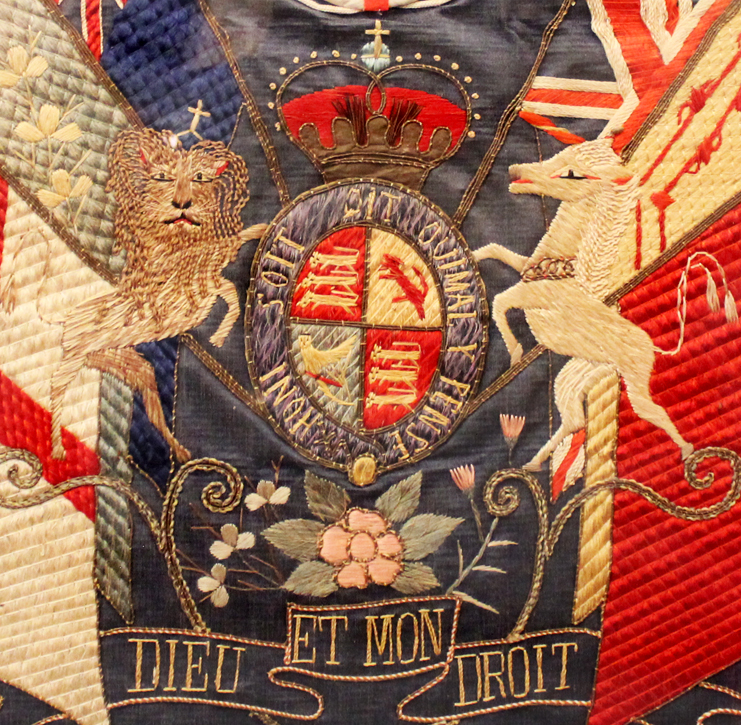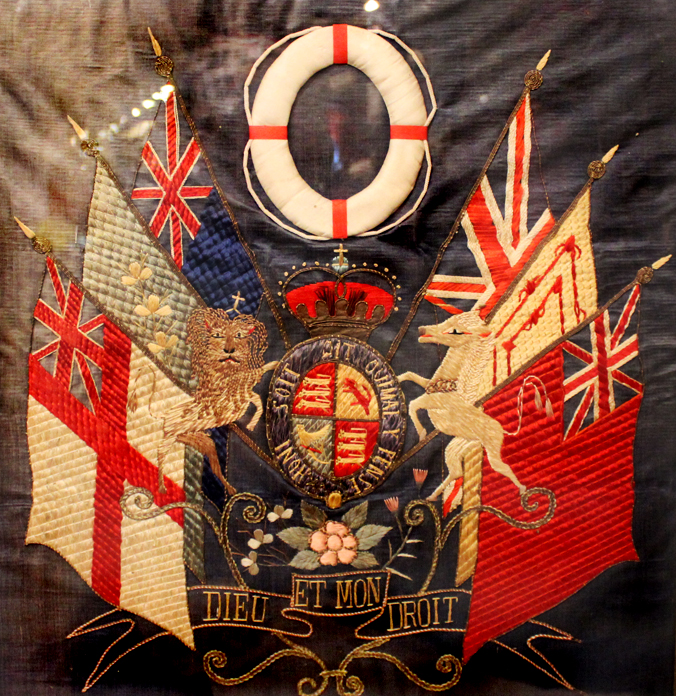A Singularly Beautiful & Rare Victorian Folk Art Silk 'Royal' Maritime Embroidery Woolwork, A ‘Jack Tar’ Sailor’s Woolwork or ‘Woolie’. The White Ensign, Red Ensign, Blue Ensign, Union Flag, Scottish Standard, Shamrock Flag
Although encompassed in the term 'woolwork', the better quality examples, such as this, were made from silk obtained by the sailors who stitched them, usually in China or Japan. Set in a simulated rosewood frame. 19th century Victorian royal crest with British maritime flags of the Royal Navy, The White Ensign, Red Ensign, Blue Ensign, Union Flag, Scottish Standard, Shamrock Flag and surmounted with a life preserver. At the base is the royal motto in a scroll 'Dieu Et Mon Droit' beneath the English rose the Scottish thistle and Irish shamrock. All on a blue silk ground with silk and embroidery decoration throughout. Often made by sailors when at sea during quiet periods and brought home for framing. Sometimes called a sailor's silkwork. From about 1840 to World War I, many British sailors passed the long hours in port or on the open sea by sewing these wool pictures, commonly called Woolies. Many have a naive charm, but some are so well executed that they rival their counterparts in oil. Primarily Woolies depict ships, but some are known to contain other subjects such as patriotic symbols, flags and crests. As Woolies were works of pride or sentiment, none were done in bad taste or caricature. Unfortunately, the names of the artists have been lost to history because Woolies tend to be unsigned. But sometimes they give us small clues as to their origin.
The enchantment of Woolies is that they are folk art. They were made by the hands of men who were not formally trained in embroidery. Regardless, it is understandable how such tough men could create such delicate pictures. Woolies are the creative product of sailors spare time, excess materials and a basic, yet necessary, familiarity with needle and thread. Until the mid-1880s the average seaman had no standard uniform. Not only did he sew his own clothes, but also one of his duties was to maintain the ship?s sails. Furthermore, sailors used embroidery to individualize and embellish their garments, frequently in eccentric designs. Therefore, spare time between watches combined with basic sewing skills and imagination became the rich soil from which the art of Woolies grew.
Most of the materials used to make Woolies were found on board ship. Sail canvas, duck cloth from sailors trousers or a simple linen or cotton fabric was used as a base. The stretcher commonly was made from excess wood with simple tenon joints, without wedges. Only the Berlin wool, cotton or silk would need to be brought from home or acquired in a foreign port. Sailors mainly chose to use vivacious colours chiefly white, blue, red, brown and varying shades of green. Early Woolies are made of naturally dyed wool. After the development of chemical dyes in the mid-1850s, sailors could obtain a greater range of colours at a less expensive price.
Only when the sailor returned home did he frame it. Today collectors frequently place woolies in maple frames, but originally the frames were quite diverse. Sometimes they were made of a simple wood; other times they were highly carved or gilded. Woolies reached their height from about 1860-80. Several events led to the eventual demise of the craft. After the advent of steam engine power, the dependency on sails and the large crews required to maintain them came to an end. This in turn influenced the size of the crews as well as their required skills. Sailors no longer needed to know how to sew in order to repair the sails, nor did they need to make their own clothing anymore. Photography also allowed a sailor to remember his travels through photographs instead of his own wool work.
Jack Tar (also Jacktar, Jack-tar or Tar) is a common English term originally used to refer to seamen of the Merchant or Royal Navy, particularly during the period of the British Empire
In the age of wooden sailing vessels, a ship's rigging was rope made of hemp, which would rot quickly in such a damp environment. To avoid this, the ropes and cables of the standing rig were soaked in tar, which had to be replenished by tarring.
Seamen were known to 'tar' their clothes before departing on voyages, in order to make them waterproof, before the invention of waterproof fabrics. Later they frequently wore coats and hats made from a waterproof fabric
Top left blue silk ground has some fading. Size 23 inches x 24 inches in frame
Code: 20991
3250.00 GBP



